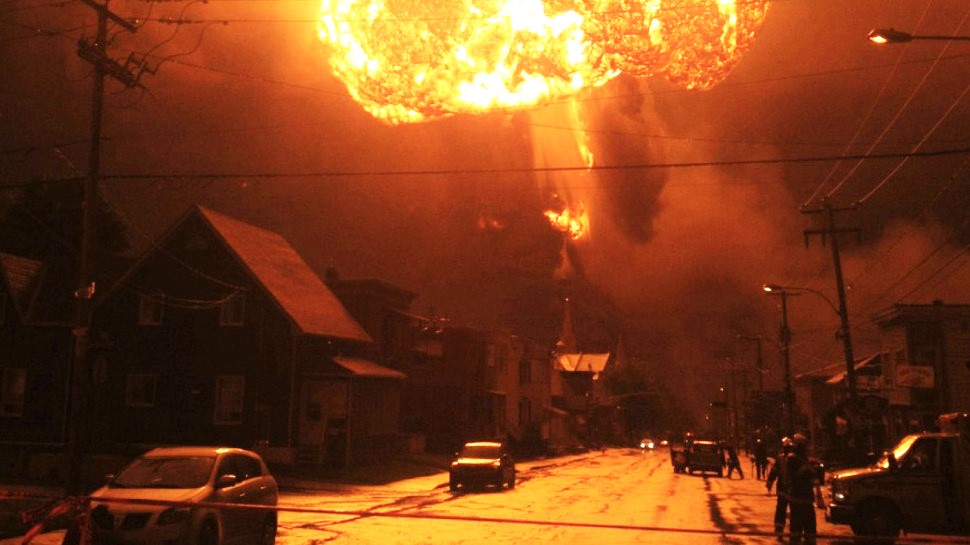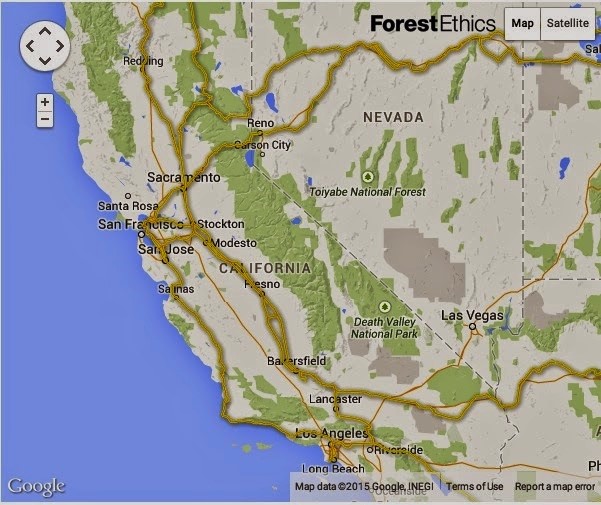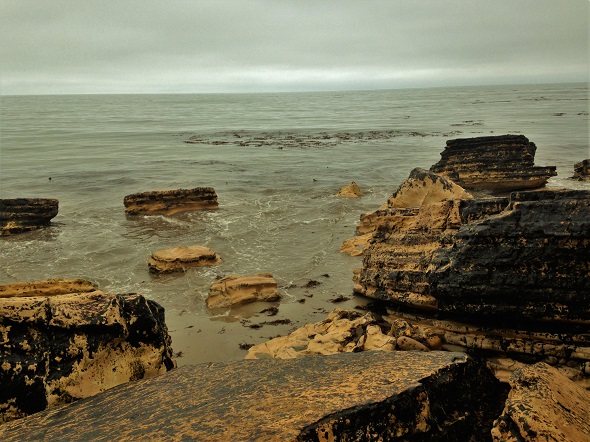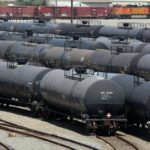We must find cleaner, safer alternatives to these ecosystem-fouling, climate-disrupting extreme fossil fuels like tar sands and fracked oil shale, and their exploding oil trains, bursting pipelines, and accident-prone refineries. The San Luis Obispo County Planning Commission rejected Phillips 66’s plan to bring in millions of gallons of toxic crude daily in 2016, and the Board of Supervisors rejected their appeal in March 2017.


On Overcoming Oil Bomb Trains and Sacrifice Zones in LA and Beyond
By Jack Eidt, Published in the LA Progressive and also in CounterPunch
This February, San Luis Obispo County will be deciding on a Phillips 66 plan to bring mile-long oil tanker trains into their Nipomo Mesa plant five days a week, each carrying 2.4 million gallons of toxic and volatile petroleum across California. So, why should the rest of us care?
Well, the descriptive term is bomb trains. Five times around North America in 2015 oil trains have crashed causing massive explosions, spills of caustic crude into rivers, fires that burn out of control, and significant property damage. The list is daunting: May 2015 in Heimdal, North Dakota, six cars of a 109-car train exploded into flames with 60,000 gallons of oil spilled. In March, an oil train derailed near Gogoma, Ontario, with a fire that destroyed a bridge. This only 23 miles from a February oil train accident where the fire burned for days. Evacuations and extreme explosions have become a game of Russian roulette, and first responders can only wonder where is next?
The February 2014 crash in North Vandergrift, Pennsylvania, [attributed to a failure in newly-laid rails] fits into an alarming pattern across North America that helps explain the significant rise of derailments involving oil-hauling trains over the last three years, even as railroads are investing billions of dollars in improving the safety of their networks. A review of 31 crashes that have occurred on oil trains since 2013 puts track failure at the heart of the growing safety problem. — Los Angeles Times
In March of 2015, near Galena, Illinois, 21 cars of a 105-car oil train derailed and burst into flames. And in February, a 109-car CSX oil train derailed and caught fire near Mount Carbon, West Virginia, leaking oil into the Kanawha River tributary, with a fire that burned for most of a week. In all of these accidents the tankers were retrofitted with protective shields to meet a higher safety standard than federal law requires, meaning the biggest problem in a world of problems was the flammable fracked oil shale or tar sands crude involved. Four more accidents happened in Tennessee, Montana and Wisconsin in 2015 where significant oil, fuel or corrosive chemicals were spilled, but without a major explosion.
The worst oil train accident by far happened July 5, 2013, with an unattended runaway train carrying fracked North Dakota Bakken shale oil, derailing and catching fire in the town of Lac-Megantic, Quebec. Forty-seven people were killed and thirty buildings burned. About 1.6 million gallons of oil was spilled. Several things are clear here: the rail tanker cars, emergency response plans, braking equipment requirements, and railroad track maintenance are inadequate. And we must find cleaner, safer alternatives to these ecosystem-fouling, climate-disrupting extreme fossil fuels like tar sands and fracked oil shale.
STORY: Hundreds Rally in Los Angeles to Stop Oil Trains


Blast Zone Running Through Our Cities and Towns
A recent analysis by the Center for Biological Diversity found that 500,000 students in California attend schools within a half-mile of rail tracks used by oil trains, and more than another 500,000 are within a mile of what some are calling the “blast zone.” In addition to the threat posed to California’s students, the report Crude Injustice on the Rails released last year by ForestEthics and Communities for a Better Environment, pointed out that in California the communities within the half-mile blast zones were also more likely to be low-income minority neighborhoods.
According to the environmental analysis on the Philips 66 oil train expansion in San Luis Obispo County, crude oil would begin moving through Los Angeles between the Inland Empire and the San Fernando Valley, passing through the Chatsworth/Northridge area already facing the largest fossil fuel gas leak blowout since the BP Deepwater Horizon, with no ability to deal with more blowouts. Furthermore, residents there remember well the 2008 Metrolink accident that took 17 lives, even without volatile crude oil added to the mix. Responding to pressure from activists, the Los Angeles City Council passed a unanimous resolution last September to oppose this project. They were not alone: six counties and 21 cities passed similar motions asking SLO to reject the project.
The oil train route would wind along the L.A. River, a source of water and recreation undergoing a $1.3 billion makeover, passing homes, hospitals, and parks, through downtown where hipster apartments and sparkling office-and-shopping megaplexes are sprouting up. The eventual goal is for oil trains to head down through South LA toward the Harbor Area, the location of the largest concentration of oil refineries in the state, and where citizen activism stopped a Valero Oil Train Expansion in 2014. The cost of our oil addiction already disproportionately impacts these communities with toxic air quality, asthma and other maladies, noise, and the threat of accidents. Time for an intervention to heal this debilitating addiction now.
Over the next 15 years, Canada’s tar sands industry plans to increase its production of the world’s dirtiest and most environmentally destructive fuels by nearly threefold. To reach this level of growth, the land-locked tar sands industry will need to find ways to access every market available, including those in the United States, Europe, and Asia. It’s main destination will be the West Coast, where there is substantial heavy oil refinery capacity and access to coastal ports. — NRDC
STORY: Santa Barbara Oil Spill: Big Oil Plans for More Tar Sands


Alternatives to the Explosive Addiction?
We must reject regular bomb train accidents as a cost of business as usual in our fast-paced, technology-addled world. We can continue to retrofit our cities and towns to provide alternatives to gridlocked freeways, with accessible public transit, car-sharing and autonomous (self-driving) technologies, free-flowing bicycle throughways, and walkable neighborhoods. We can invest in the development of more efficient automobiles made of fiber composites, powered by solar and wind power or advanced biofuels.
Rather than sacrifice our railroads built for passengers and light cargo, not 100-car bomb trains bent on destabilizing our climate in the name of getting to work on time, we can look to the work of the visionaries, Mark Z. Jacobsen’s Solutions Project, Amory Lovins’ Rocky Mountain Institute, and Arjun Makhijani’s Carbon Free, Nuclear Free. We can and will transition to an economy focused on efficiency, conservation, and renewable and clean sources of energy, but it has to happen now. And we must overcome the excesses of capitalism, where politicians like Mr. Obama and Mr. Brown, who spout concepts of energy sustainability can be bought with the power of dark money to push for more pipelines, oil trains, hydraulic fracking wells, holding fast to the addiction. Presidential candidates like Bernie Sanders or Jill Stein have the ability to separate themselves from the oil lobby billions: the rest of them, not so much. Sacrifice zones like Porter Ranch and Wilmington, along with extreme droughts and superstorms, as well as cancer-clusters and death by explosions, don’t have to be the cost of “doing business.”
Mark Jaccard, a professor of sustainable energy at Simon Fraser University in Vancouver who has served as CEO of the British Columbia Utilities Commission, is not alone in suggesting that because of concerns about climate change and low oil prices, the era of tar sands megaprojects may be at an end. “This is not good for high-cost oil resources, such as oil sands,” says Jaccard. “And if major countries such as the U.S., China, and the European Union continue their modest climate push, there will be further challenges to high-emissions oil sources, such as oil sands.” — Yale Environment 360
[cincopa AAAAYRdfyX5X]
Instead of bringing tar sands crude from the strip-mined Boreal forests of Alberta, the Phillips 66 Santa Maria Refinery should transition their workers into providing sustainable energy for the 21st Century. Our communities and our planet demand a world with clean air and water, safe from exploding bomb trains.
httpvh://youtu.be/Hyq7X7VJgnc
Jack Eidt serves on the Steering Committee of SoCal 350 Climate Action, a Los Angeles affiliate of the international climate change organization 350.org.
Updated March 14, 2017













Pingback: L.A. Area Students Speak Out Stop Oil Trains | WilderUtopia.com